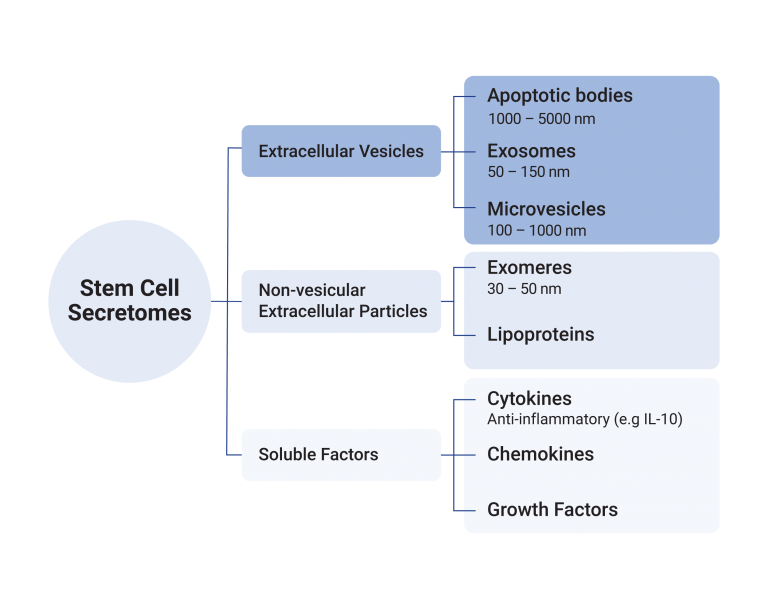Extracellular particles are tiny, EP include vesicular (membrane-bound) and non-vesicular particles released by cells. These include exosomes, microvesicles, exomeres, apoptotic bodies, and other non-vesicular biomolecules. Their main function is to transport biological materials like RNA, proteins, and lipids between cells.
These particles typically range in size from 30 nanometer (nm) to 5 micrometer (µm) – much smaller than mesenchymal stem cells (MSCs), often around 20 times smaller.
In the past, extracellular particles were believed to be part of the cell’s waste removal system, responsible for discarding unwanted cellular components. However, recent research has shown that exosomes, microvesicles, and exomeres play a vital role in cell-to-cell communication. They deliver biological signals that help regulate various cellular processes and functions.

Extracellular particles (EPs) are a broad category of cell-released components that include exosomes, microvesicles, exomeres, and other non-vesicular particles. Exosomes are a specific subtype of EPs—small (30–150 nm), membrane-bound vesicles formed inside cells and released through the endosomal pathway. While all exosomes are EPs, not all EPs are exosomes. The main difference lies in their size, origin, and function, with exosomes playing key roles in intercellular communication, while EPs as a whole serve a wider range of biological and clearance functions.
All cells secrete nanoparticles such as extracellular particles (EPs). EPs derived from umbilical cord mesenchymal stem cells are considered superior in quality because these stem cells are younger, more primitive, and highly potent.
EPs, especially exosomes, are being explored as cell-free therapies because they can carry bioactive molecules like proteins, RNAs, and lipids.
- Regenerative medicine: Promote tissue repair in heart, liver, brain, skin, and joints (e.g. MSC-derived exosomes for wound healing or osteoarthritis)
- Immune modulation: Reduce inflammation, modulate autoimmune responses
- Cancer therapy: Deliver anti-tumor agents or miRNAs to cancer cells
This table highlights why freeze-drying is often preferred over freezing, especially for preserving sensitive materials. It compares both methods in terms of storage, protection, transport, and long-term effectiveness.
| FREEZE-DRIED | FROZEN | |
|---|---|---|
| Storage Requirement | Best stored below 4°C | Must stay at -80°C or below |
| Protection | Protected with lyoprotectant | No added protection |
| Membrane Integrity | Outer layer stays strong during drying | Ice crystals can break the outer layer |
| Shelf Life | Lasts for years without freezing | Quality drops quickly if not kept at -80°C or below |
| Transport | Easy (No cold shipping needed) | Difficult (Needs continuous cold chain) |
| Usage Effectiveness | Works well after rehydration | Can lose strength if frozen / thawed too often |